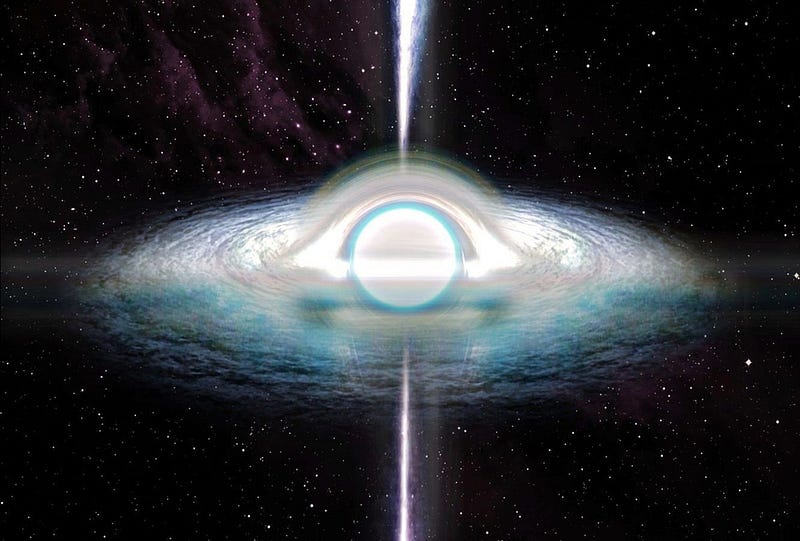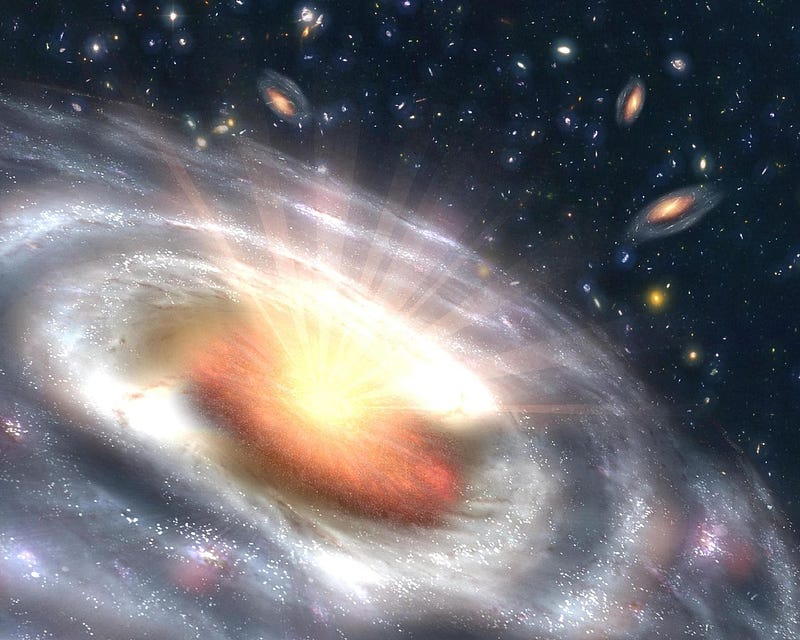The Fascinating Concept of White Holes: Beyond Black Holes
Written on
Chapter 1: Understanding White Holes
A white hole is a theoretical cosmic phenomenon that is believed to be the opposite of a black hole. The question arises: do such entities truly exist?

[Photo: Baperookamo, CC BY-SA 4.0, via Wikimedia Commons]
To grasp the concept of white holes, we first need to revisit the fundamentals of black holes.
Section 1.1: The Formation of Black Holes
Black holes originate from the death of massive stars. When a star exhausts its nuclear fuel, its metallic core collapses under immense gravitational force, creating a singularity—a point of infinite density. This region of space-time is so severely warped that nothing, not even light, can escape.
Astrophysicist Subrahmanyan Chandrasekhar demonstrated that stars can end their existence in various ways, depending on their mass. While lighter stars transform into white dwarfs, those exceeding a specific mass threshold succumb to their gravity, leading to a supernova explosion and potentially forming a neutron star or a black hole. The Chandrasekhar limit is set at approximately 1.44 solar masses, a finding that earned him the Nobel Prize in 1983.
Physicists theorize that stellar black holes can merge, resulting in the formation of supermassive black holes.
Section 1.2: What Exactly Is a White Hole?
In theory, a white hole could possess properties that are fundamentally opposite to those of a black hole. It would be a region where matter and energy emerge from a singularity. However, to date, no empirical evidence supports the existence of such entities. Some scientists speculate that if white holes were real, they might be unstable and eventually convert into black holes.
Interestingly, black holes and white holes might be interconnected. What a black hole absorbs, a white hole could theoretically expel. This connection is referred to as the Einstein-Rosen bridge, a concept proposed by Albert Einstein and Nathan Rosen in 1924. However, subsequent analyses revealed that such bridges are likely unstable.
This instability is unfortunate since they could function as so-called space-time tunnels, linking disparate regions of the universe. These tunnels, often depicted in science fiction, would facilitate rapid interstellar travel. Presently, researchers have succeeded in creating a miniature version of a space-time wormhole within a quantum computer.
Chapter 2: Are Quasars White Holes?
Quasars are among the brightest entities in the universe, appearing to our eyes as luminous stars. The term "quasar" is a contraction of "quasi-stellar object." They are located at vast distances and emit intense radiation, often ejecting jets of matter into space.
This led to the hypothesis that quasars might be candidates for white holes. In reality, the light from quasars originates from a swirling mass of heated matter being drawn into a supermassive black hole, with the jets resulting from interactions between this matter and the black hole's formidable gravitational field.

[Photo: NASA, Public domain, via Wikimedia Commons]
Section 2.1: Is a White Hole Comparable to a Big Bang?
Some physicists propose that when a massive star collapses, it creates an infinitely dense point, potentially leading to a Big Bang—a theory that suggests a new universe might emerge. If this idea holds true, the Big Bang itself could be regarded as a white hole.
This notion is applicable to the Big Bang that initiated our universe roughly 13.7 billion years ago. From that "moment zero," space began to expand, carrying matter with it, ultimately forming the cosmos we know today.
Section 2.2: The Fate of Matter in Black Holes
What becomes of the matter and energy consumed by black holes? Their gravitational pull is so immense that anything crossing the event horizon is unable to escape, not even light. Nevertheless, these cosmic giants emit radiation, a phenomenon theorized by the late Prof. Stephen Hawking.
Due to quantum effects, black holes can "evaporate," releasing energy in the process. Eventually, this could allow astronomers to observe them. As black holes lose mass, they shrink at an accelerating rate until they vanish entirely.
In this way, the matter and energy consumed by black holes eventually escape, albeit in a transformed state. Physicists often say that "a black hole has no hair," meaning that the information regarding what was once inside is irretrievably lost.
The first video titled "What Is a White Hole? (Opposite of Black Hole)" delves into the concept of white holes, exploring their theoretical existence and properties.
The second video, "What Happens When a White Hole and a Black Hole Collide?" examines the fascinating interaction between these two theoretical entities and what it might mean for our understanding of the universe.
Cool that you made it to the end of this article! If you found this information valuable, please show your support by leaving some claps or even following me. Your tips are greatly appreciated! Thank you!